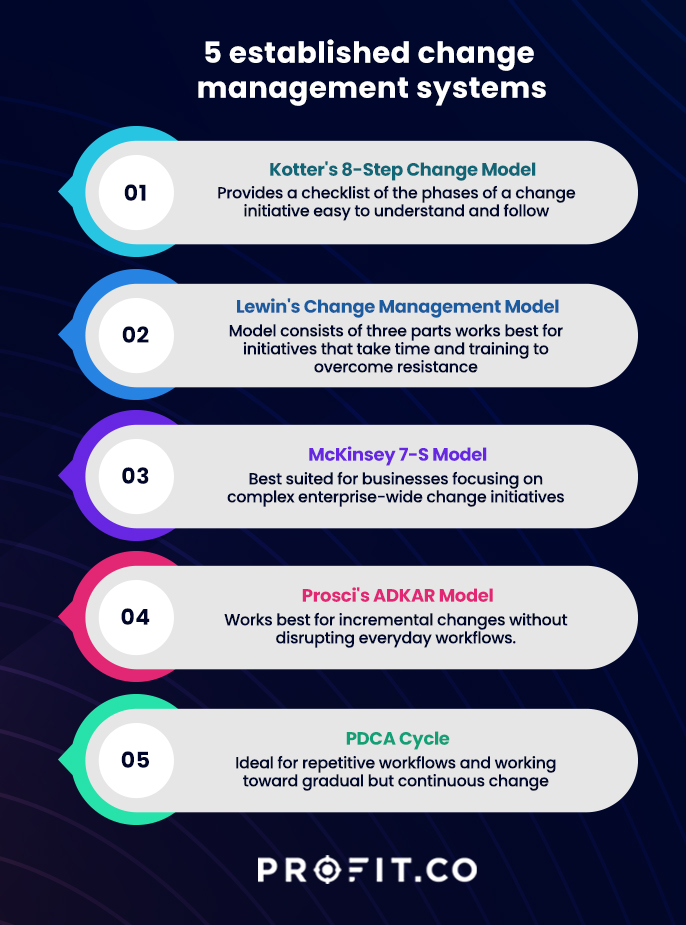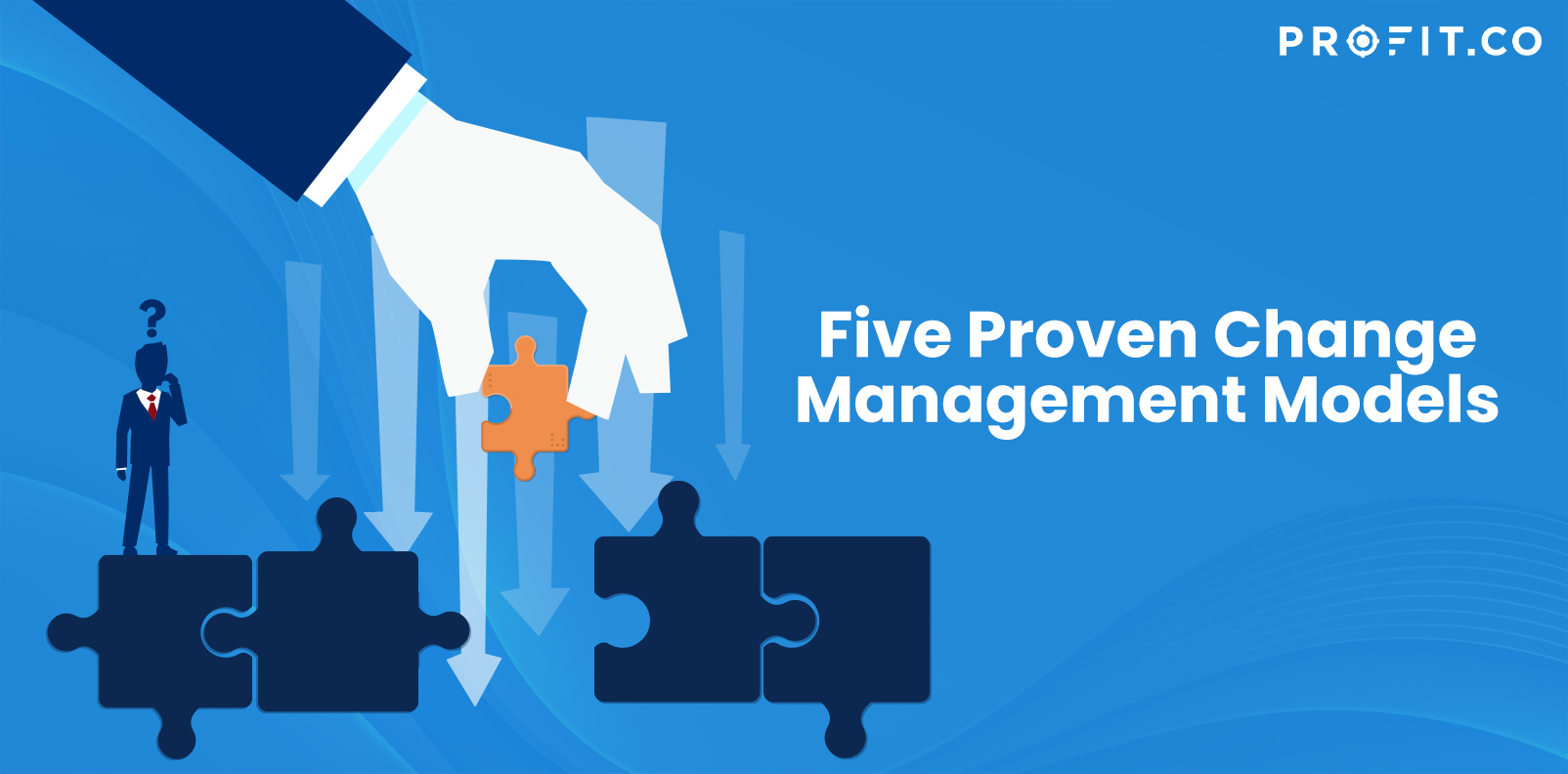Organizational change is challenging as a business grows. The more employees you have, the more people you need to convince them of the benefits of change. Various change management models can help business leaders implement change, but the choice of model depends on your context. This guide explores five change management frameworks that assist organizations in accomplishing successful transformations.
What is Change Management?
Change management is the process of outlining and implementing business tasks needed for a transition without disrupting workflows. This transition may involve changing or upgrading business software, shifting organizational culture, or guiding a business through a merger or acquisition.
Innovation is the ability to see change as an opportunity – not a threat.
What are the Change Management Models and their Importance?
Change management models are the theories, methodologies, and concepts that guide organizational change. These models look at the change process from start to finish, offering steps or solutions that make the initiative easier to implement. Change management models are excellent learning opportunities for organizational leaders in charge of transformative projects. You can use one model or a combination of several frameworks if it fits your initiative’s goals and delivers a smooth and effective change process.
Five Most Effective Organizational Change Management Models
Some change management principles work best for large-scale enterprise changes, while others suit smaller projects with fewer complex steps. For example, you’ll require an in-depth change model to implement a digital transformation project from legacy to cloud-based applications. In contrast, you may choose a simplified change model to automate your invoicing workflow.

Here are five established change management models to consider.
1. Kotter’s 8-step change model
Created by Harvard professor John Kotter, this 8-step change management model is a checklist of the phases of a change initiative. Kottler identified the following steps.
- Create a sense of urgency: Make a compelling case for your change initiative for all your stakeholders.
- Build a change team: Identify the change leaders in various departments according to their skills.
- Define your strategic vision: Formulate a clear statement about your change initiative, including practical steps to accomplish the change.
- Communicate the vision: Make everyone aware of the initiative through verbal and written communication, including visual aids to engage your stakeholders.
- Remove change barriers: Identify potential roadblocks and sources of friction that slow down the change initiative, such as emotional resistance, knowledge silos, or logistical problems.
- Set short-term goals to celebrate the benefits of the change early. This way, you break down the change plan and get more buy-in as your team sees a positive impact.
- Sustain the momentum throughout the change implementation process through consistent communication, regular reviews, and adding on the benefits of short-term wins.
- Anchor the change once the initiative is complete to make the changes a permanent part of your organization. Incorporate the change into your policies, guidelines, and procedures.
2. Lewin’s change management model
Social psychologist Kurt Lewin developed a three-phase model that’s become one of today’s most popular change management theories. This model breaks down a change initiative into three parts: unfreeze, change, and refreeze.
- Unfreezing: This involves raising awareness of the need for change, getting buy-in from stakeholders, and motivating everyone to accept the coming transition.
- Change: This step is also called the transition or implementation phase. Stakeholders become “unfrozen” and endorse or apply the change. Change is the most challenging step of this framework as leaders confront their team’s uncertainties and fear of negative consequences.
- Refreezing: As stakeholders accept and internalize the change, leaders reinforce the change adoption with incentives, rewards, and support to make the change permanent.
While this change model has only three phases, it doesn’t guarantee a quick transition. The Lewin model works best for initiatives that take time and training to overcome resistance.
3. McKinsey 7-S model
Created by business consultants Robert H. Waterman Jr. and Tom Peters, the McKinsey 7-S Model divides change initiatives into the following parts.
- Strategy is the long-term business plan with a strong mission, vision, and values.
- The structure is the company’s organizational chart.
- Systems are everyday processes and procedures that inform business decisions.
- Shared values are the benchmarks and values that influence employee behavior.
- Style is the management approach of the C-suite team.
- Staff is the employees in an organization and their training, motivation, and rewards.
- Skills are the capabilities and competencies of the staff involved in the change initiative.
These factors are the hard S (strategy, structure, systems) and soft S (style, staff, skills, shared values). The hard elements are easier to identify than the soft ones, but both are critical to successful change implementation. The McKinsey 7-S Model best accommodates businesses focusing on complex enterprise-wide change initiatives. It helps you identify misalignments you may otherwise miss with a simpler change management model.
4. Prosci’s ADKAR model
Prosci’s founder, Jeffrey Hiatt, created the ADKAR Change Management Model for awareness, desire, knowledge, ability, and reinforcement. It focuses more on individual contribution than the processes that need to change.
The ADKAR goals are the following.
- Awareness: Explain the reasoning behind the change initiative and encourage shareholders to raise concerns about the process.
- Desire: Designate change leaders that engage with shareholders. Demonstrate the initiative’s benefits to retain their interest and support.
- Knowledge: Train and educate individuals and teams about the change. Introduce new skills gradually to avoid overwhelming your stakeholders, which leads to resistance to change.
- Ability: Build your stakeholders’ confidence in implementing the change through hands-on coaching.
- Reinforcement: Solidify the change by continuously rewarding stakeholders for accomplishing the change, correcting old habits, and gathering feedback about the initiative’s impact.
The ADKAR approach works best for incremental changes without disrupting everyday workflows. ADKAR can also accelerate change implementation since it emphasizes employees and teams who actualize the initiative.
5. PDCA cycle
PDCA is a project management framework for “plan, do, check, and act.” It’s also called the Shewhart Cycle after its creator, Dr. Walter Shewhart. PDCA is ideal for repetitive workflows and working toward gradual but continuous change in the change management context.
The PDCA procedure follows the steps below.
- Plan: Identify the challenge you want to overcome or an opportunity to pursue in your change management strategy.
- Do: Test the plan through small experiments or trial runs in a real-world context.
- Check: Evaluate the results and gather data about the initial test, then determine if the change is feasible or needs adjustment.
- Act: Implement the change across the department or organization based on insights from the previous steps.
The PDCA Cycle is continuous. The model requires continuous testing, analyzing, implementing, and building upon your change management strategy. Choose this framework to implement slow but incremental changes in your organization. Be prepared to revisit your original change management ideas with each test and analysis to ensure you align the change with your overall business objectives.
Conclusion
Understanding all the change management models above will help you choose the best fit for your business. A change management framework reveals the right path toward change with minimal shareholder pushback. No matter what model you choose, it is essential to prioritize clear communication, remain open to feedback and offer continued support for lasting organizational change.



